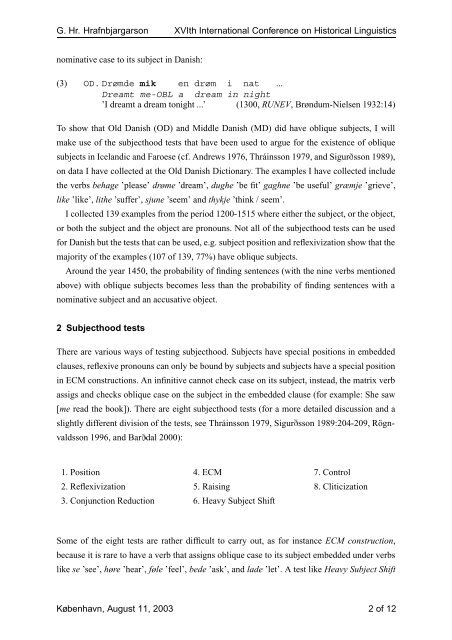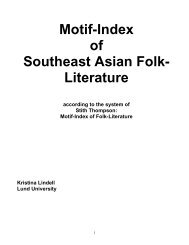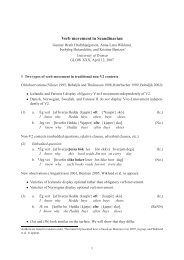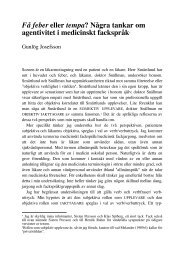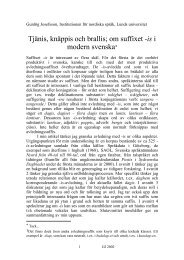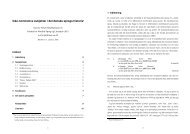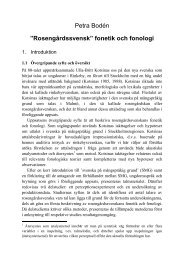Non-Nominative Subjects in Old and Middle Danish
Non-Nominative Subjects in Old and Middle Danish
Non-Nominative Subjects in Old and Middle Danish
Create successful ePaper yourself
Turn your PDF publications into a flip-book with our unique Google optimized e-Paper software.
G. Hr. Hrafnbjargarson XVIth International Conference on Historical L<strong>in</strong>guistics<br />
nom<strong>in</strong>ative case to its subject <strong>in</strong> <strong>Danish</strong>:<br />
(3) OD. Drømde mik en drøm i nat ...<br />
Dreamt me-OBL a dream <strong>in</strong> night<br />
’I dreamt a dream tonight ...’ (1300, RUNEV, Brøndum-Nielsen 1932:14)<br />
To show that <strong>Old</strong> <strong>Danish</strong> (OD) <strong>and</strong> <strong>Middle</strong> <strong>Danish</strong> (MD) did have oblique subjects, I will<br />
make use of the subjecthood tests that have been used to argue for the existence of oblique<br />
subjects <strong>in</strong> Icel<strong>and</strong>ic <strong>and</strong> Faroese (cf. Andrews 1976, Thrá<strong>in</strong>sson 1979, <strong>and</strong> Sigursson 1989),<br />
on data I have collected at the <strong>Old</strong> <strong>Danish</strong> Dictionary. The examples I have collected <strong>in</strong>clude<br />
the verbs behage ’please’ drøme ’dream’, dughe ’be fit’ gaghne ’be useful’ græmje ’grieve’,<br />
like ’like’, lithe ’suffer’, sjune ’seem’ <strong>and</strong> thykje ’th<strong>in</strong>k / seem’.<br />
I collected 139 examples from the period 1200-1515 where either the subject, or the object,<br />
or both the subject <strong>and</strong> the object are pronouns. Not all of the subjecthood tests can be used<br />
for <strong>Danish</strong> but the tests that can be used, e.g. subject position <strong>and</strong> reflexivization show that the<br />
majority of the examples (107 of 139, 77%) have oblique subjects.<br />
Around the year 1450, the probability of f<strong>in</strong>d<strong>in</strong>g sentences (with the n<strong>in</strong>e verbs mentioned<br />
above) with oblique subjects becomes less than the probability of f<strong>in</strong>d<strong>in</strong>g sentences with a<br />
nom<strong>in</strong>ative subject <strong>and</strong> an accusative object.<br />
2 Subjecthood tests<br />
There are various ways of test<strong>in</strong>g subjecthood. <strong>Subjects</strong> have special positions <strong>in</strong> embedded<br />
clauses, reflexive pronouns can only be bound by subjects <strong>and</strong> subjects have a special position<br />
<strong>in</strong> ECM constructions. An <strong>in</strong>f<strong>in</strong>itive cannot check case on its subject, <strong>in</strong>stead, the matrix verb<br />
assigs <strong>and</strong> checks oblique case on the subject <strong>in</strong> the embedded clause (for example: She saw<br />
[me read the book]). There are eight subjecthood tests (for a more detailed discussion <strong>and</strong> a<br />
slightly different division of the tests, see Thrá<strong>in</strong>sson 1979, Sigursson 1989:204-209, Rögnvaldsson<br />
1996, <strong>and</strong> Bardal 2000):<br />
1. Position 4. ECM 7. Control<br />
2. Reflexivization 5. Rais<strong>in</strong>g 8. Cliticization<br />
3. Conjunction Reduction 6. Heavy Subject Shift<br />
Some of the eight tests are rather difficult to carry out, as for <strong>in</strong>stance ECM construction,<br />
because it is rare to have a verb that assigns oblique case to its subject embedded under verbs<br />
like se ’see’, høre ’hear’, føle ’feel’, bede ’ask’, <strong>and</strong> lade ’let’. A test like Heavy Subject Shift<br />
København, August 11, 2003 2 of 12


